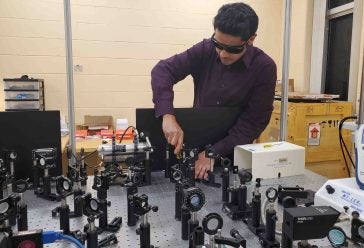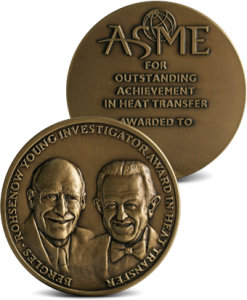By Neil Nachbar
He’s only been a professor since 2020, but Ashutosh Giri, assistant professor of mechanical engineering at the University of Rhode Island, is quickly making a name for himself in the field of heat transfer.

“I’m passionate about this field because of the new challenges brought forth by nanotechonology and the emergence of the research field of nanoscale heat transfer,” said Giri. “This field allows me to focus on the fundamental science and the innovative engineering aspects of the research, which has the potential to make a huge impact on the energy landscape and solve some of the grand challenges in science and engineering.”
The field of heat transfer dates back to Sir Isaac Newton’s work in the early 1700s. However, the burgeoning interest in nanotechonology over the past two decades has presented challenges that cannot be adequately resolved with the classical heat transfer laws that were pioneered by people such as Newton.
One of the research topics on which Giri and the students in his lab are working is thermoelectric power generation.
“We are highly interested in this topic because about 70 percent of energy generation in the United States is wasted as rejected heat,” said Giri. “We’re focused on trying to convert wasted heat into reusable energy to alleviate some of the energy demands of our society. We do this through engineering materials at the nanoscale, which would ultimately increase the efficiency of devices that incorporate these materials.”
Carl-Ernst Rousseau, professor and chair of the Mechanical, Industrial and Systems Engineering Department at URI is impressed with what Giri has accomplished in the field of heat transfer in a short period of time.
“It’s astounding that within two years of his arrival at URI, Ash has established himself as one of the researchers who shows the most promise nationally in revolutionizing the field of heat transfer,” said Rousseau. “Ash not only attempts to solve engineering problems, but he also searches deeply into the physics of the cases he investigates. This sets him apart from his peers.”
Giri was named the 2022 recipient of the Bergles-Rohsenow Young Investigator Award, which is presented to an engineer under the age of 36 who has demonstrated the potential to make significant contributions to the field of heat transfer. Contributions may take the form of analytical/numerical methods, equipment/instrumentation, or experimentation.
“I feel humbled and honored to receive this award, especially considering the list of people who previously won the award,” said Giri.
Giri was nominated for the Bergles-Rohsenow award by Patrick Hopkins, a professor at the University of Virginia who was his advisor as a doctoral student.

“Ash’s research has been devoted to advancing both the computational and experimental metrologies utilized to study heat transfer at the nanoscale,” wrote Hopkins in his nomination letter. “He has not only provided a strong platform for the younger generation of researchers, but he has also extended the community’s fundamental knowledge of the physics of energy carriers.”
The American Society of Mechanical Engineers has selected an engineer for the Bergles-Rohsenow Young Investigator Award annually since 2003. For winning the award, Giri will receive a $1000 cash prize, a bronze medal and a certificate.
In 2021, Giri received the Office of Naval Research’s Young Investigator Award for his research on “Unraveling the Microscopic Dynamics of Coupled Energy States in Nanostructures.” The three-year grant was for $500,000.
